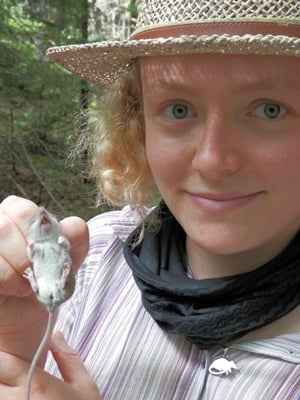 Wildlife Encounters in Nova Scotia
Wildlife Encounters in Nova Scotia
By Alysa Hulbert (Biological Sciences 3rd Year)
As a Biological Sciences student in my final year at Oxford, I am required to undertake a research project. This can be in any area of biology providing I can find a supervisor willing to take me on. I've always had a soft spot for rodents so I was drawn to the work of Dr Christina Buesching, who has conducted research on small mammal behaviour in Oxford University's Wytham Woods, and so I sent her an email expressing my interest. To my surprise she replied that she now lives not in Oxford but in Nova Scotia, Canada, and that she would be happy to have me come over during the summer vacation to collect data in her forest research site! This explains how in mid-July, just in time to escape the London 2012 Olympics, I found myself in the beautiful forested hills and wild rocky shores of Atlantic Canada. Home for the next five weeks was a cosy wooden cottage from which it was possible to stroll down to the sea in no time at all, so I hardly cared at all that I didn't have a TV to watch the Opening Ceremony! As I arrived there was a snowshoe hare on the lawn and that first night we ran out at dusk to see a porcupine that had climbed into a sapling at the end of the garden. This set a precedent for the coming weeks of frequent exciting wildlife encounters; muskrat, beaver, white-tailed deer, raccoon, woodchuck, skunk, garter snake, snapping turtle, osprey and loon.
Every day we would set out in the morning to the field site, whether it was poetically misty, or the pine boughs were bent with the rain or, as happened quite often, it was baking hot and sunny. Our aim was to assess the ecological impact of logging by comparing the vegetation structure, microclimate and, most importantly, the small mammal populations between areas of land which were cleared twenty years ago and areas of untouched forest. The main task was checking the hundred traps we had set the night before and should they have been tripped, carefully extracting the occupant, identifying its species, then recording location where trapped, age, sex, weight and reproductive status. They'd then be marked and released. I really enjoyed handling the animals and also getting to know a few of the more interesting individuals, such as one male red-backed vole that would range up to 100m in a single night seeking a mate. However my favourite was the first animal I caught; another vole, this time a pregnant female, who got rounder and heavier each day until one morning we opened the trap to find her surrounded by her little pink baked-bean-like babies.
Aside from the all-too-frequent horror of finding a tick crawling under your clothing and once getting bitten by a feisty chipmunk I enjoyed every single moment. I was privileged to be able to learn from Christina and her partner Dr Chris Newman, also a member of Oxford University's Wildlife Conservation Reseach Unit (WildCRU). They taught me how to recognise field signs such as coyote tracks, black bear prints and bobcat scat and determine how long ago the animal passed by and what it had been doing.
This fantastic trip would not have been possible had it not been for the generous contribution from the Brasenose College Annual Fund for which I am extremely grateful.
Read more about Biology at Brasenose
